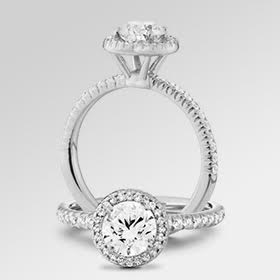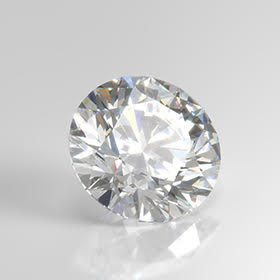When we think of a diamond, we think about a shiny stone with a flat top, multiple sides, and a pointy bottom. However, diamonds do not start like that. Diamonds are rough-looking stones in nature. It takes precise cutting and polishing before it can be used in jewelry. In this blog, we will take a look at how diamonds are cut.
Rough diamonds look like rocks without any shine or sparkle. A jeweler cuts a diamond into a proper shape and then polishes it to give it a good luster. Only after this a diamond is used for engagement rings. Diamond cutting is a process where parts of diamonds are shaved off. This is done until a desired shape is attained. This cutting process dictates the quality, value, and beauty of the diamond. Jewelers perform this delicate action of diamond cutting with their skills, expertise, and specialized tools.
How Are Diamonds Cut for Engagement Rings?
The process of cutting a diamond is known as diamond cutting. It involves several steps to transform a rough diamond into a polished gemstone with various facets. Only a diamond can cut a diamond. Here is the overview of how a diamond is cut.
Planning is the most important factor when it comes to cutting diamonds. Careful planning is required in the process of diamond cutting. A jeweler examines the rough diamond to determine the best way to cut the diamond. This leads to an increase in the beauty and value of the diamond. Factors like size and shape are considered during the planning stage. Then, the rough diamond is usually first cleaved or sawed into smaller pieces to make the cutting process easy. This process involves either splitting the diamond along its natural planes. A laser or a diamond saw is used in this process.
After this, bruting is conducted. This process is also called rounding. It is the process of shaping the diamond into a round shape. According to reports, two diamonds are placed in rotating tools called a lathe. The edges of the diamond then grind against each other until both diamonds acquire a circular shape. Bruting is one of the most important parts of diamond cutting. After the bruting process comes the blocking process. In this process, a diamond is cut into a specific shape called a pavilion. The pavilion is the bottom part of the diamond that will form the main facets of the diamond.
After this process comes the faceting part. Faceting is the most intricate and time-consuming stage of diamond cutting. Skilled cutters of the diamond use a grinding wheel to create facets on the diamond’s crown and pavilion. The arrangement and number of facets vary depending on the desired shape of the diamond. It can be a round cut, princess cut, emerald cut, or marquise cut.
Once the facets are cut, the diamond goes through the process of polishing. In the polishing stage, a polishing wheel coated with a polishing agent is used. This can involve diamond powder. The cutter carefully polishes each and every facet to ensure a smooth and reflective surface. After polishing, a jeweler inspects the diamond thoroughly to make sure that it meets the specific quality standards. The cutter checks the diamond for any flaws like scratches or inclusions that may have appeared during the cutting process. After a diamond has been cut and polished, it is ready to be sold or turned into unique engagement rings and oval engagement rings.
These diamonds can also be used for wedding bands and engagement rings for women. Natural diamonds are sold for higher prices than lab-grown diamonds. We suggest that you opt for a lab-grown diamond rather than natural diamonds. This is mainly because both types of diamonds are similar to each other in terms of physical and chemical properties. However, there is a difference when it comes to the price of the diamonds.










